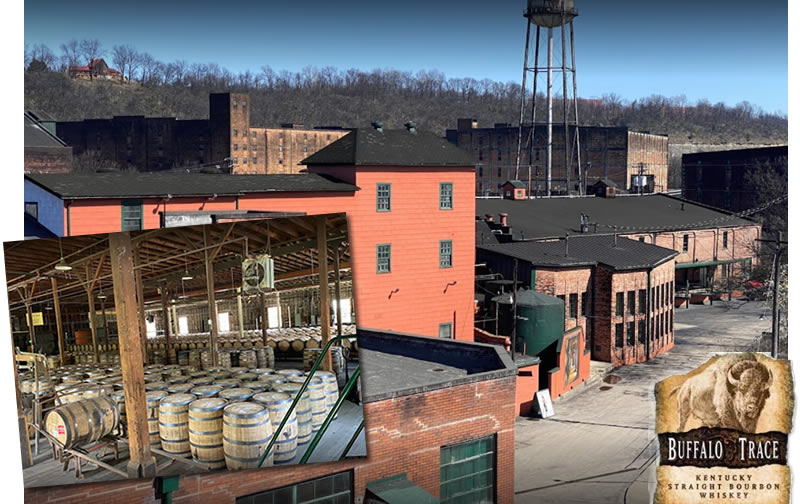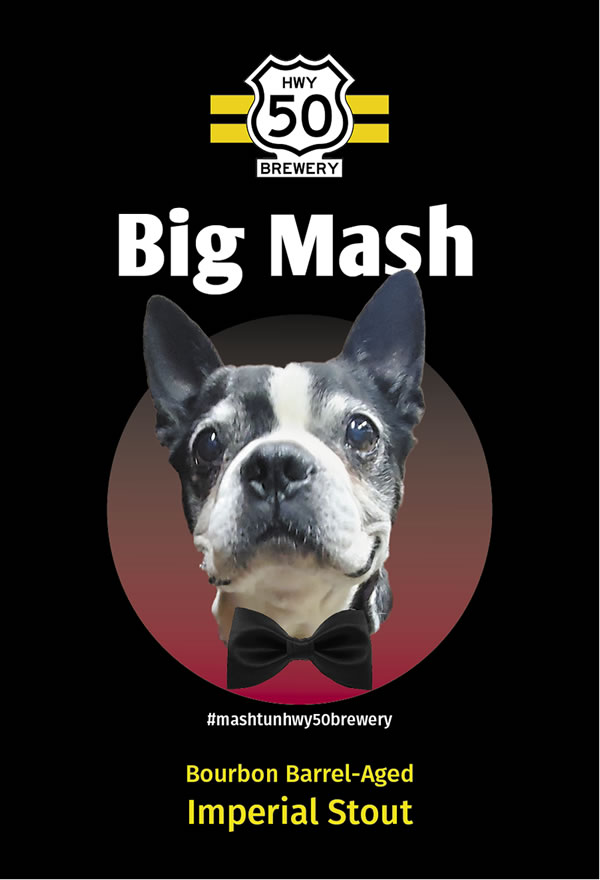
Mango, Tangerine and Coconut: Hwy 50’s Single-hop, One Way IPAs
October 12, 2021
Wit Line Fever
October 31, 2022
Barrel Aged Big Mash Imperial Stout
by Gary Ritz
4/27/2022
H ere’s news our beer-loving friends have been waiting for over the past 13 months or so. Our barrel-aged Big Mash Imperial Stout (at time of writing) is in bottles and on tap.
This is a traditional style Imperial Stout aged in bourbon barrels from Buffalo Trace Distillery in Kentucky. After dubious sampling sessions, we can honestly say, we're really happy with the results. It's got rich coffee and chocolate coming through, as well as dark fruits like plums and raisins from the barrel aging. It’s a 10% alcohol beer, so not over the top. (Our 1990 brewhouse was never built to do a 10% beer, but we make it work!)
The Malt
This stout has a lot of grains and some interesting choices that really give it layers of complexity to enjoy.
For example, the two-row malt. I used a pale ale malt on this that has a slightly darker roast than regular two-row.
Also, where I might have used black patent malt, which is a very dark roasted malt and has a tendency to bring some astringency to a beer, I chose a roasted barley which is not malted. It adds some of that red hue you see in this beer, but most importantly it adds those really beautiful coffee flavors.
I used a chocolate malt too—which is common in Imperial Stout and which I really enjoy. So, I tend to push a little more of the chocolate on this. But not to worry, no actual chocolate was harmed in the making of this beer!
I also use a variety of crystal malts—a couple different roasts on those. These are malts that have already gone through a bit of a mash process, then through roasting, the sugars are caramelized which brings a little bit of sweetness and adds to that beautiful silky mouthfeel. I used some oats as well, which also lends to the mouthfeel.
I used a couple other specialty malts too that lend some character and even more complexity.
Speaking of complexity, this is one of those beers—if you let it warm a little before drinking, the complexity develops even more. Temperature has a big effect on our palates. The colder the drink, the less sensitive our palate is to flavors. Let this beer sit a few minutes and it will get more complex and more beautiful.
The Hops
I made certain choices concerning the hops. You can see with some of our other beers, I have a certain affinity for British beers, and I wanted to follow that tradition here. So I kept the hops a little more subdued than in some of the American imperial stouts. I used English bittering hops almost entirely. These are hops with very low alpha acids, resulting in a very restrained bitterness. A little bit of hop carries through in the flavor but very faintly, and absolutely nothing on the aroma.
The Barrels
After fermenting, we put the beer into our two Buffalo Trace bourbon barrels and just left it alone to age for over a year.
I love aging in these barrels. The bourbon in the wood adds those wonderful bourbon notes, and the oak lends some really nice vanilla that comes through in the background along with a touch of cinnamon.
Aging is something I did back when I was homebrewing. I’d make imperial stouts and would soak wood cubes in bourbon, then decant the bourbon off and add the cubes to the beer. Then…patience! Let it sit until it's ready. I would have a carboy—five gallons of this precious black gold—sitting in my closet waiting. A year later I'd put it in a keg and enjoy it with some close friends while it lasted.
Here it doesn’t hide in a closet! We put the barrels right out on the taproom floor where they get those temperature fluctuations from day to day and season to season that allows the beer to move in and out of the wood, pulling those great flavors and aromas with it.
Even though those barrels play a big role, I can’t control what they’re doing—and anyone will tell you that I’m big on maintaining consistency in my beers. But even between the two barrels there were subtle differences. One had surprisingly big vanilla aromas and the other was a little more boozy—had more of the Buffalo Trace coming through. We blended them together and came out with a balance that’s neither overly vanilla or overly boozy. Balance is really hard to achieve anyway, but especially when you have only two barrels.
Next time we'll do four!
The Bourbon
So why use bourbon barrels? Because one, it complements this imperial stout very nicely. When you taste it, I know you’ll agree. Two, bourbon is truly an American drink. It originated in the South where it was too warm for barley to grow but not for corn. Corn makes horrible beer, but when it’s distilled, it creates bourbon. (To this day there are laws stating you can only label it “bourbon” if it’s made with at least 51% corn and aged in barrels made of American oak.)
So while Imperial Stout has its origins in England—from historical times when the English sold their stout porters to the Imperial courts in Russia, and to make the journey by ship, they gave it a higher alcohol content—I think it's nice to honor our own tradition by letting this English style beer evolve and mature in American tradition barrels. It’s a lot of fun, and the results are phenomenal.
Age-worthy Beer
What I like about these beers is that they age phenomenally well. Beer, being alive as it is, changes over time, and this beer will lay down just like a good wine.
In the Baltic Sea, not long ago, they found an old sailing ship that went down on its journey from England to Russia. What made the news is that they found some close to 200-year-old wine on that ship sitting at the bottom of the sea. And it was still drinkable! They also found bottles of what is likely to be Imperial Stout. One report mentioned it was drinkable too! Now, what “drinkable” means, I don’t know, but they say it was.
When we bottle one of our beers—whatever style or vintage—we put a case of it aside. A few years down the road, we’ll open a bottle to see how it's maturing. If our guests are buying a beer that they're going to lay down for three, four or five years, I want to make sure I've sold them something that will do that well. The only way to do that is sensory testing over time. If I find something there that I can make better with change, I’ll make whatever change I need in my current aged beers to make them better over the years.
The Name and Label
We called this beer Big Mash, because it was the biggest mash we have put through our brewhouse. The Mash bill came in at over 1,200 pounds of milled grain for 8 barrels (a US barrel is 31 gallons). Most of our beers are under 800 pounds for 12 barrels.
The term mash is a brewing term referring to mixing milled grain with a given volume of water at a specific temperature. Mashing converts the starches to sugar. This process takes place in the mash tun.
As for the label, we shamelessly used our beloved brew dog, Mash Tun. We thought our little gentleman was a perfect fit for a beer that doesn’t know it’s size. As you can see, he was all dressed up and ready for his debut.
As many of you already know, we lost our little gentleman in March. He will be greatly missed, but thanks to Big Mash, he will be remembered every time we see a bottle of this delightful barrel-aged imperial stout.
The Promise Inside
The cost of making this beer is huge. The time it requires in tying up a fermenter. The cost of the barrels which has gone through the roof. The space necessary to store the barrels. The cost of the best ingredients. The 16 months or so it takes start to finish.
If I didn't think I could produce a product worth spending the time and money on, or that guests would enjoy and be willing to pay for, I wouldn't do it.
When we first opened the brewery in 2018, I never would have tried a beer like this Imperial Stout. There were so many elements to the process we had to figure out. We had to figure out the water. The yeast. We had to figure out the brewhouse, for goodness sake—how it would react and respond in differing circumstances. Our 15-barrel brewhouse was built at a time when 5.5% was a big beer. How the times have changed.
So we waited to make a beer like this until I was comfortable, had enough understanding of our system, and had brought the quality of our everyday beers up to a level I felt I could be proud of.
I've always believed that sincerity and integrity are the backbone of this business. I've always insisted on being authentic. Part of authenticity is knowing your weaknesses and your strengths and making the effort to be in sync with them in what you do.
The thing about our barrel-aged beers is that there’s a promise in those barrels. People come in and see them and they know they’re not just for looks. They know and feel the promise inside. It’s an anticipation that grows over a year’s time. Some who are most interested come in often and we have great discussions over what's happening. If they’re lucky enough, it will be on a day we pull some out for a taste and to check the progress.
I love that all of this gives people a kind of ownership in what we're doing. I think this can extend to everything a local craft brewery is and does. Beer-making right on the premises becomes a community process and it has been that way for centuries. These barrel-aged beers bring a high point and embody that unifying spirit. Plus, they taste so good! You can’t help but swirl some in your mouth and just smile. The silky richness. The deep layers of flavor. The only thing that makes the experience better is to share it with someone.
I am proud of our barrel-aged Imperial Stout. I’m glad it turned out so well. More than that, I’m proud and humbled to be a part of what I’ve written here. I see my work as a promise and a privilege that I try to live up to every day.
Thank you to everyone who has supported us over the past 3 ½ years. We wouldn’t be here without you.





